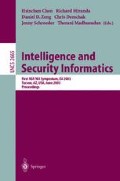Abstract
Associating criminal incidents committed by the same person is important in crime analysis. In this paper, we introduce concepts from OLAP (online-analytical processing) and data-mining to resolve this issue. The criminal incidents are modeled into an OLAP data cube; a measurement function, called the outlier score function is defined on the cube cells. When the score is significant enough, we say that the incidents contained in the cell are associated with each other. The method can be used with a variety of criminal incident features to include the locations of the crimes for spatial analysis. We applied this association method to the robbery dataset of Richmond, Virginia. Results show that this method can effectively solve the problem of criminal incident association.
Access this chapter
Tax calculation will be finalised at checkout
Purchases are for personal use only
Preview
Unable to display preview. Download preview PDF.
References
Badiru, A.B., Karasz, J.M. and Holloway, B.T., “AREST: Armed Robbery Eidetic Suspect Typing Expert System”, Journal of Police Science and Administration, 16, 210–216 (1988)
Brantingham, P. J. and Brantingham, P. L., Patterns in Crimes, New York: Macmillan (1984)
Brown D.E. and Hagen S.C., “Data Association Methods with Applications to Law Enforcement”, Decision Support Systems, 34, 369–378 (2003)
Brown, D. E., Liu, H. and Xue, Y., “Mining Preference from Spatial-temporal Data”, Proc. of the First SIAM International Conference of Data Mining (2001)
Clarke, R.V. and Cornish, D.B., “Modeling Offender’s Decisions: A Framework for Research and Policy”, Crime Justice: An Annual Review of Research, Vol. 6, Ed. by Tonry, M. and Morris, N. University of Chicago Press (1985)
Chaudhuri, S. and Dayal, U., “An Overview of Data Warehousing and OLAP Technology”, ACM SIGMOD Record, 26 (1997)
Dong, G., Han, J., Lam, J. Pei, J., and Wang, K., “Mining Multi-Dimensional Constrained Gradients in Data Cubes”, Proc. of the 27 th VLDB Conference, Roma, Italy (2001)
Everitt, B. Cluster Analysis, John Wiley & Sons, Inc. (1993)
Felson, M., “Routine Activities and Crime Prevention in the Developing Metropolis”, Criminology, 25, 911–931 (1987)
Hauck, R., Atabakhsh, H., Onguasith, P., Gupta, H., and Chen, H., “Using Coplink to Analyse Criminal-Justice Data”, IEEE Computer, 35, 30–37 (2002)
Hawkins, D., Identifications of Outliers, Chapman and Hall, London, (1980)
Heck, R.O., Career Criminal Apprehesion Program: Annual Report (Sacramento, CA: Office of Criminal Justice Planning) (1991)
Icove, D. J., “Automated Crime Profiling”, Law Enforcement Bulletin, 55, 27–30 (1986)
Imielinski, T., Khachiyan, L., and Abdul-ghani, A., Cubegrades: “Generalizing association rules”, Technical report, Dept. Computer Science, Rutgers Univ., Aug. (2000)
Kaufman, L. and Rousseeuw, P. Finding Groups in Data, Wiley (1990)
Mitra, P., Murthy, C.A., and Pal, S.K., “Unsupervised Feature Selection Using Feature Similarity”, IEEE Trans. On Pattern Analysis and Machine Intelligence, 24, 301–312 (2002)
Salton, G. and McGill, M. Introduction to Modern Information Retrieval, McGraw-Hill Book Company, New York (1983)
Sarawagi, S., Agrawal, R., and Megiddo. N., “Discovery-driven exploration of OLAP data cubes”, Proc. of the Sixth Int’l Conference on Extending Database Technology (EDBT), Valencia, Spain (1998)
Scott, D. Multivariate Density Estimation: Theory, Practice and Visualization, New York, NY: Wiley (1992)
Sturges, H.A., “The Choice of a Class Interval”, Journal of American Statistician Association, 21, 65–66 (1926)
Author information
Authors and Affiliations
Editor information
Editors and Affiliations
Rights and permissions
Copyright information
© 2003 Springer-Verlag Berlin Heidelberg
About this paper
Cite this paper
Lin, S., Brown, D.E. (2003). Criminal Incident Data Association Using the OLAP Technology. In: Chen, H., Miranda, R., Zeng, D.D., Demchak, C., Schroeder, J., Madhusudan, T. (eds) Intelligence and Security Informatics. ISI 2003. Lecture Notes in Computer Science, vol 2665. Springer, Berlin, Heidelberg. https://doi.org/10.1007/3-540-44853-5_2
Download citation
DOI: https://doi.org/10.1007/3-540-44853-5_2
Published:
Publisher Name: Springer, Berlin, Heidelberg
Print ISBN: 978-3-540-40189-6
Online ISBN: 978-3-540-44853-2
eBook Packages: Springer Book Archive

